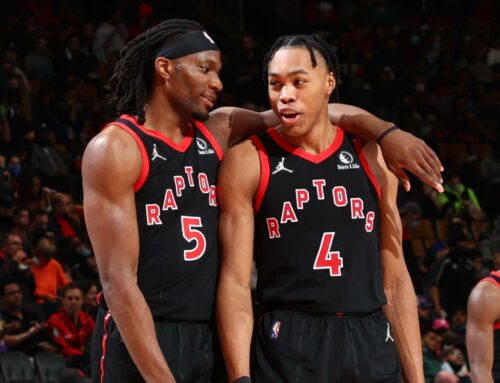***This post is the third of a series discussing the importance of shooting and developing a good shot. Read Part I explaining shooting’s value in modern basketball. Read Part II to learn how crucial your legs are for a good shot.
1. Body Alignment: “Every part of your body must align.”
2. Limit the Ball’s Motion: “Shoot the ball in one singular upward motion.”
3. Guide-Hand Only: “Don’t let that non-shooting hand move!”
4. Eyes on the Rim: “Know where you are looking.”
I gotta be frank with you.
I write these articles to help you improve your shot – which they will!
But honestly.
There is no one right way to shoot a basketball.
Take a look across the NBA. All kinds of stuff is going on.
Some shooters’ strokes are sweet as honey…
(Steph Curry is third all-time in made three-pointers)
Some are damn ugly but pure…
(Reggie Miller is second!)
And some are just wrong…
You never really know what special blend of mechanics is going to be right for you. There is no singular scientific way to hoop. Maybe that is what is so wonderful about basketball – or so terribly frustrating.
But. BIG BUT. Capital B-U-T…But.
There are some basic principles – VERY IMPORTANT PRINCIPLES – that can help get your stroke from clunk-ville to flamethrower-town.
1. Body Alignment
“Every part of your body must align.”
It all has to be in place:
feet
knees
legs
hips
chest
elbow
wrist
hands
head
All of it.
Why? Two reasons.
One, alignment is accuracy.
You want your shot to go where you intend it (the hoop, duh). The easiest way to do that is to have your whole body working towards that goal. Each part NOT facing the hoop limits precision and, likely, affects another moving part. Imagine throwing a baseball to someone and your hips are turned another direction. Your torso will want to follow your hips and your arm is going to want to follow your torso. Look out innocent by-standers!
Two, alignment is consistency.
Like I said before, if one part of your shooting-motion moves funky, then each following part of your shot is going to compensate…and move funky. Your body parts move more naturally when in alignment with one another. Watch Klay Thompson. Whether he is spotting up or moving into a pass, he squares his body to the hoop and aligns his body parts shot after shot after shot.
2. Limit the Ball’s Motion
“Shoot the ball in one singular upward motion.”
Murphy’s law says that something in the universe will go wrong if you give it the opportunity to go wrong.
In other words, the more movement the ball experiences – from shooting pocket to release – the more likely an error occurs. Additional movement also slows your time of release down.
Little-to-no bobs: Many players catch a ball and lower it from their shooting pocket for momentum and strength. That is okay if it is in motion and quick. But catching the ball, then lowering, then going up to shoot can be slow. Rely on your legs for your shot’s power so you can start your shot from where you catch the ball.
No hitches: Granted this is an extreme example, but you can see with Markelle Fultz’ shot (see below), how a hitch separates a shot into two disconnected shooting motions. The second motion – the release – renders the first motion useless. All that power and foundation of mechanics is compromised. The shot needs to flow in one start-to-finish motion.
Practice: This Steve Nash drill emphasizes the single shooting motion and the core and leg strength it requires.
3. Guide-Hand Only
“Don’t let that non-shooting hand move!”
Young players use their non-shooting hand to add strength to their shot – as though they were chest passing to the hoop. Your legs – NOT YOUR ARMS – are responsible for your shot’s power.
The non-shooting hand should barely move. It is there simply to stabilize your shot by making sure the ball remains steady in your shooting hand.
Practice: Shoot one-handed shots under the basket (swishes only). After 5 in a row take a step back. Repeat until you are too far for one-handed shots. Go back and do the same thing with your non-shooting hand guiding the ball.
Watch Ryan Anderson and Klay Thompson practice the drill.
4. Eyes On the Rim
“Know where you are looking.”
It’s a shooter’s preference. But ask yourself, “Where do I look when I shoot?”
A coach asked me once and I had no idea. He suggested I find a spot on the rim (front or back) and look at it every time I shoot. It’s like throwing darts. If you want to throw a bullseye you don’t look at the whole dartboard you look directly at the centre of the bullseye.
Same is true for a shot. An exact target – a spot on the rim as opposed to the hoop in general – helps you hone the accuracy of your shot.
Hint: I always look at the back of the rim because I tend to shoot short.
There is no right way to shoot a basketball. We all have our own mechanics.
But these principles – along with the other articles – will help.
Remember, sometimes your shot may have to change. Even superstars need a shot doctor to treat their ailing form.
Then, after all this reading, get in a gym. Put up lots and lots and lots of shots. Record your progress. Over time, with improved mechanics, you will find yourself shooting at a faster, more consistent, and accurate rate.





